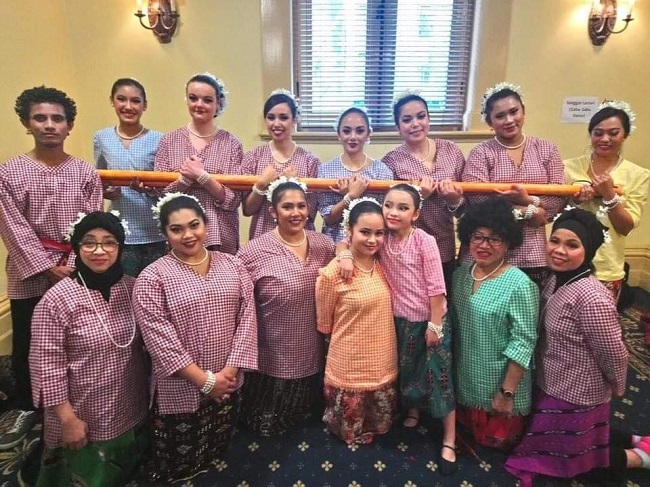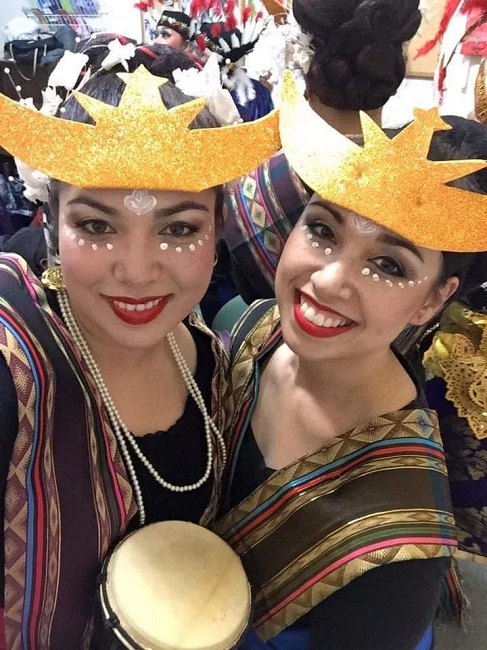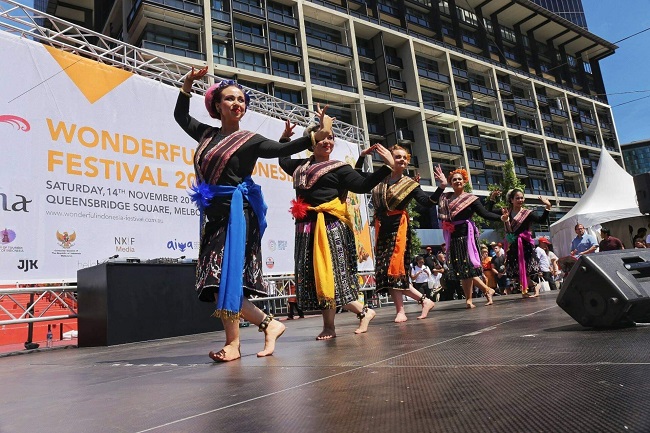The mixed-race identity of Indonesian-Australian cultural performers
Sisters Mira and Yana were born in Australia to an Indonesian mother and Australian father of Irish descent and identify as ‘half-half’: they feel both Australian and Indonesian and equally at home in both places. While their childhood was spent in Australia, their mother Ningsih ensured they embraced Indonesian culture. Amongst the Indonesian diaspora, Ningsih is regarded as having successfully raised culturally literate Eurasian daughters. As Yana explains, being part of her mother’s dance school has enabled the sisters to feel continually immersed in Indonesian culture.
The dance group’s approximately 30 members are like a ‘big family’ for Mira and Yana, an Australian version of the cousin-like relationships typically associated with an Indonesian extended family. Indeed, the group contains three sets of sisters who are ‘half-half’ (Indonesian and Anglo-Australian mixed background) or Eurasian, as well as their Indonesian mothers and some Australian-born friends.
Being an outsider
In an interview with Yana and Mira, as part of a social science research project on the lives of Asian-Australian artists, they described feeling like outsiders due to having a mixed identity that was not accepted in either Australia or Indonesia. For example, the Indonesian extended family from their mother’s side sometimes call them ‘tourists’ when they visit Indonesia. Meanwhile, the Australian extended family from their father’s side call them ‘the Indonesian cousins’.
Challenges to their mixed identity also occur outside their family. In 2017, they were asked by the Indonesian Ministry of Tourism to be Australian cultural representatives in Indonesia as part of the Ministry’s promotional program, ‘Wonderful Indonesia’. As part of the program, the sisters visited Indonesian traditional dance institutions and learnt dances from different ethnic groups. Some Indonesians they encountered made derogatory remarks about them being ‘too dark skinned’ to fulfil expectations of Australian visitors. This misunderstanding is repeated in their Anglo-Australian residential suburb where they are labelled the ‘Asian sisters’ in contrast to other predominantly white children at school.

Yana and Mira deal with these racially charged encounters by working with their mother to produce their own hybrid Indonesian dance pieces. They regularly perform in Australian multicultural festivals, Indonesian community events and various educational and cultural exchange events. As outsiders, they feel they can be both Indonesian cultural ambassadors in Australia, and vice versa.
Performing diversity
Yana and Mira’s experiences are shaped by the complex multicultural history of Australia, as well as Indonesia’s own racialised history. In Australia during World War II, as described by historian Joost Cote, so-called ‘Indische’ siblings, the children of Indonesian and Dutch parents, seeking asylum in Australia were often separated when they encountered the White Australia policy – those deemed pale enough were accepted for migration, while those with darker skin were rejected. This historical desirability of paler skin tones has enabled some Indische descendants who have a ‘whiter-skinned, Eurasian look’ to achieve stardom and success in Indonesia, Australia and the Netherlands, particularly in television.
The dance troupe in which the sisters perform could play to such cultural preferences, emphasising the desirability of their own paler skin tones and Eurasian ‘look’, similar to the Indische. They could also seek to reproduce the Indonesian taste for dance troupes comprising women of uniform appearance. In contrast, this dance group does the opposite. As Yana states: ‘[We] don’t even care that they look a bit mismatched... At the end of the day you’re promoting a culture... The great thing is the different sizes, shapes, body types and whatnot.’
Unlike the emphasis in Indonesia on uniformity, Yana draws on understandings of Australian multiculturalism, in which diversity and difference are valued and an object of celebratory display. This attentiveness to diversity is also evident in the dances that the group perform, in contrast to groups in Indonesia that tend to work with a narrow range of local dances. Instead, their choreographer mother Ningsih draws on dances and traditions from across Indonesia, incorporating them into a unique program of Indonesian dance as a representation of a diverse nation. As Mira explains: ‘I think the main aim was always from the start, for my mum anyway, was just breaking down misconceptions of Indonesia... like I love it when we do dancing from other islands to the east of Indonesia, people come up to you and say, “Wow there’s so much more to Indonesia”... so that was her main aim.’
The misconceptions Mira refers to are the dominant media depictions in Australia of Indonesia as either a hotbed of Islamic terrorism or the brochure paradise of Balinese tourism. This tendency for extremist or orientalist images overlooks the reality of Indonesia’s 300 different ethnic groups. By performing a variety of dances, particularly from the predominantly non-Muslim eastern part of Indonesia, the dance group seeks to challenge assumptions about Indonesia held by both Australians and Indonesians. As Mira explains, they seek to change perceptions not through language, but through movement and performance.
For the sisters, Australia and Indonesia are inextricably entwined. Australia is the taken-for- granted backdrop to their Indonesian identity, even as their Indonesian identity is what provides them with an entry point to being multicultural Australians. The public emphasis on Australia as multicultural gives them licence to articulate both their Australian and Indonesian identities through their sense of being Indonesian. Mira adds, ‘especially living in Australia, we’re going to embrace the Indonesian side a lot more’. Yana elaborates, ‘What even is Australia? It’s multicultural. So we might as well identify as Indonesian, and it makes mum happy’.
In addition to performing, the sisters are actively involved in promoting the group as well as aspects of Indonesian culture on social media, including Instagram, Twitter and YouTube , and have also hosted virtual dance classes on Facebook live and Zoom since 2019. Their YouTube channel has over 120 subscribers with up to 2000 views for their performance videos, and in general their posts are received positively with encouraging comments. Social media allows them to share their affinity with Indonesia more widely as Mira explained, to ‘encourage people from around the world to join us in learning Indonesian dances’.

However, engaging on a public platform is not without downsides. Mira acknowledges what can be seen as race-based attitudes from her online Indonesian audience, for example, that they are too ‘bule’ (foreign). It is a term used in Indonesia for foreigners, particularly those with lighter skin. ‘It’s like there is an initial barrier where some Indonesians instinctively resist our teachings, maybe because they feel we’re not 100 per cent authentically Indonesian.’
Negotiating identity
For Mira and Yana, being Australian-Indonesian mixed race means they have to negotiate experiences in two respects. First, the ideas of whiteness that frames them as not white enough, having slightly darker skin with Asian features, and thus different to Anglo-Australian children.
At the same time they are not considered white enough by some Indonesians to be Australian cultural representatives in Indonesia. Second, they negotiate their identities with a sense of intergenerational pride associated with being ‘half-half’ or ‘Indo’, stemming from a colonial discourse of being Indische or bule.
Residing mainly in Australia, the sisters could opt to symbolise the Western, cosmopolitan and upwardly mobile identity prized in social media, including by the Indonesian diaspora. But instead they consciously use dance to challenge certain Indonesian aesthetics, drawing on their experiences as Australian-Indonesians. They perform dances from the lesser known eastern parts of Indonesia with dancers of racially mixed Asian-Australian backgrounds at events that celebrate both Australian and Indonesian identities, thus challenging race-based assumptions in the two countries.
Monika Winarnita is a Lecturer in Indonesian Studies at Deakin University, Burwood Campus, Melbourne Australia. This article is part of research published with co-authors Regan Maiquez and Raelene Wilding: Mixed-Race Habits: Articulations of Female Asian-Australian Artists.












